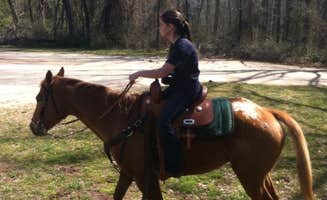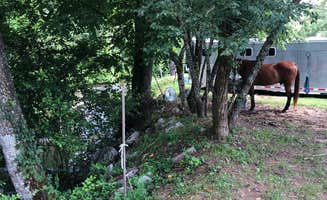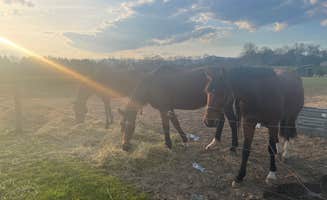Equestrian camping opportunities exist 30-40 miles from Central, South Carolina in the Sumter National Forest and nearby areas. The region's forested terrain contains elevation changes of 1,000-2,000 feet, creating diverse riding environments from creek bottoms to mountain vistas. Weather conditions vary significantly by season with summer temperatures averaging 85°F and winter lows frequently dropping below freezing.
What to do
Creek exploration: The North Fork French Broad River runs through Lazy J Campground, providing accessible water features for campers. "We camped right along the river. It felt like we were camping deep in the woods and the Fall leaves were still clinging to the trees and made it absolutely beautiful. We fished right next to our camp site and then relaxed with a camp fire listening to the sound of the River," reports one visitor.
Trout fishing: Several streams in the area provide fishing opportunities, particularly at North Mills River Campground. Located approximately 60 miles from Central, the campground offers direct access to stocked waters. "We live not too far from this campground, so it's more like our backyard outdoor playground. As you wind back to reach the campground, there is a section to the right of the road for hook-ups. Across the bridge there are more spots for tents and campers," explains one regular visitor.
Trail riding: The network of horse-friendly trails connects multiple camping areas throughout the region. Access points include several designated equestrian camping facilities with specific trail designations. One rider states, "Some of the best Horse Camping in the Mountains, Great Horse trails that follow the Chatooga River."
What campers like
Campsite layouts: Willis Knob Horse Camp receives positive feedback for its organization and amenities. "There are nine campsites. Sturdy highline posts are provided but you need to bring your own ropes and other highland gear. Vault toilets are provided but no shower facilities. Campsites each offer electric and water hookups, nice tent pads, lantern hooks, and big picnic tables," explains a visitor.
Water features: Multiple campgrounds feature streams or lakes as central attractions. At Standing Indian Campground, approximately 75 miles from Central, campers appreciate the natural water features. "We could hear the stream from our site at night. Exactly what we were looking for... Trails all around the site and longer ones further down the road. Hiked on the Appalachian and went to take the blue trail that takes you to the summit of Standing Indian Mountain," reports one camper.
Clean facilities: Maintenance standards receive consistent praise at several locations, particularly during peak seasons. Regular cleaning schedules and well-maintained common areas contribute to positive experiences. "Bathrooms were always clean and seem to have been recently redone. Sites were small but not overly so," mentions one visitor to Standing Indian Campground.
What you should know
Seasonal variations: Water systems at horse camps typically operate from April through October, with limited or no water during winter months. Temperature fluctuations affect camping comfort significantly throughout the year.
Site reservations: Advance booking is essential during peak equestrian season (April-June and September-October). Most designated horse camping areas fill quickly on weekends.
Trail conditions: Panthertown Valley Backcountry Area, located about 50 miles from Central, requires proper navigation tools. "It is imperative to purchase a decent map for these trails and I highly recommend using the one available via the Friends of Panthertown website. This is a beautiful area with tons of dispersed camping. You will really need to pack a bear safe food container and absolutely store food using a bear line well away from camp as there are most certainly bears out and about."
Wildlife awareness: Bear activity requires proper food storage and awareness, particularly in more remote camping areas. Bear-resistant containers are strongly recommended at backcountry sites.
Tips for camping with families
Creek access: Sites adjacent to water features provide natural entertainment for children. "Great campground with great hosts and great fishing. Beautiful lake with crystal clear water. Easy access. Very relaxing atmosphere," notes a visitor to South Cove County Park, which is located just 7 miles from Central.
Playground facilities: Several developed campgrounds maintain play equipment for younger visitors. "My family stayed at South Cove on a Friday night. We were impressed with the large number of pull through sites and the cleanliness of the campground. We arrived late in the day and the camp hosts were friendly and quick to assist with checking in. There are several large play areas in walking distance."
Wildlife viewing: Morning and evening hours present optimal viewing opportunities for native species. Keeping a respectful distance reduces stress on animals and increases observation success.
Junior ranger programs: Seasonal educational activities at state parks provide structured learning opportunities for school-age children. Programs typically run on weekends during summer months.
Tips from RVers
Site leveling: Multiple reviews mention uneven terrain at equestrian campgrounds. Bringing additional leveling blocks helps accommodate the natural topography. "Campground was well maintained, with pretty views. Campsites are often uneven with a lot of tree roots running throughout. It does require consideration before parking your trailer or RV," advises one camper at Oconee State Park Campground.
Hookup limitations: Most horse-focused campgrounds offer limited electrical service and no sewer connections at individual sites. Plan water usage accordingly, especially during multi-day stays.
Road access: Access roads to horse campgrounds typically include steep grades and sharp turns. Smaller trailers (under 30 feet) navigate these conditions more successfully than larger rigs.
Weather planning: Seasonal storms can create challenging conditions on forest roads. Check weather forecasts before departure and allow extra travel time during inclement weather.




